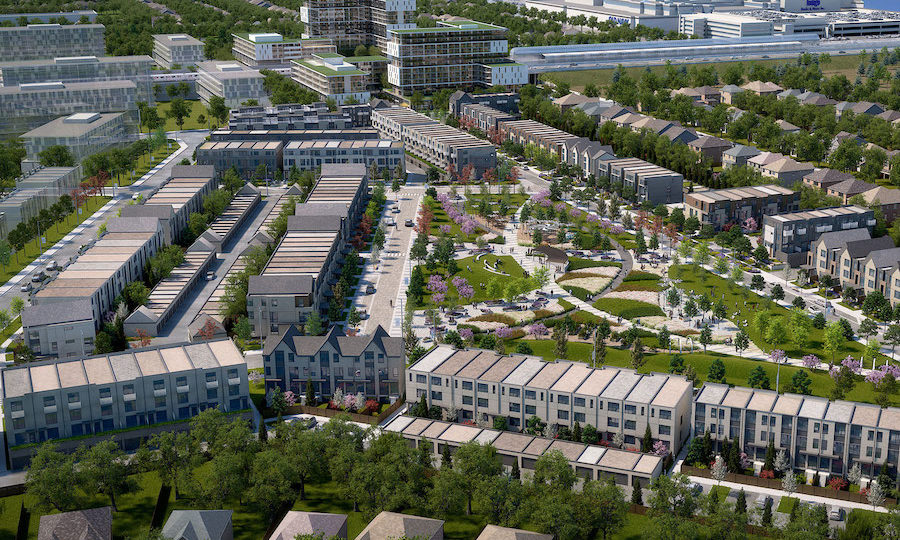A Lawrence Heights development with pre-built secondary rental units is being pitched as a solution to the housing crisis
A Toronto real estate development near Yorkdale mall is offering townhomes with a municipally approved secondary unit option. 52 per cent of the buyers at the Lawrence Heights development have opted to buy with a purpose-built legal rental unit, according to a representative from developers Context and Metropia.
The unique, pre-sold option giving buyers a potential rental income is just one example of how Toronto developers can respond to the housing crisis in the real estate market. Better and smarter building is crucial to accommodate a population, which is leading to decisions that affect the environment.
“There are thousands and thousands of people moving into our region,” Ontario NDP housing critic Jessica Bell told NOW during a real estate podcast discussing the housing affordability issue. “Once the pandemic is over, immigration will go up again. The real question is, where are we going to house people and how are we going to make sure it’s affordable?”
The Ontario government has responded to the housing affordability crisis by issuing Municipal Zoning Orders (MZOs) that bypass municipalities and give developers access to build on important sites like the Pickering wetlands or the Dominion foundry.
On top of that, Ford has been pressuring areas such as Guelph, Hamilton and Durham Region to extend boundaries to allow for further development. Ontario’s greenbelt is also under threat with Ford’s push for a new highway 413 through its protected farmland, forests, rivers and lakes. A Toronto Star and National Observer investigation revealed that the 413 would benefit developers who are donors to the Ontario PC Party.
Earlier this week, it was announced that Ford appointed retired MPP Norm Sterling to lead the Greenbelt council, replacing David Crombie, who resigned complaining that Ford was undermining the ability to protect the environment. Crombie’s replacement voted against the creation of the Greenbelt in 2005, which makes him an ideal choice to allow Ford to continue running roughshod over the environment.
On the NOW podcast, Bell urged real estate developments to think about smarter ways to accommodate the population increase without paving over green space.
“It’s really critical that we look at gentle intensification, these missing middle properties, so that we can house people but we’re not building on valuable greenbelt and valuable farmland,” she said.
The pre-planned secondary units at Lawrence Heights is a gesture in that direction.
Philip Kocev, the broker of record at iPro Realty, advocates for more mid- and- low-rise homes built in existing Toronto neighbourhoods, which can serve a market unable to afford single-family homes with an alternative to sky-rise towers. Kocev says small developers and politicians need to push back against NIMBYism and bylaws to build the missing middle.
“They need to be willing to go against their constituents who don’t want some of these developments in their neighbourhoods,” says Kocev. He adds that Toronto is unique in a way that sets us back, since single-family homes dominate in areas like the Danforth. “What other international city do you know where you get off the subway station and you walk into essentially a neighbourhood.”
Bell also says smart development with gentle intensification is needed for areas outside trying to accommodate the urban exodus out of the Toronto real estate – neighbourhoods that won’t need to rely on a highway like the 413 or encourage more people to spend more time in cars.
“A far better solution is to look at how can we move forward on urban planning,” says Bell. “[Build] complete communities where people can live and work and play and study close together, so taking public transit, biking and walking are all reasonable options. and you also have an affordable home.”
One such planned community called The Orbit is coming to the town of Innisfil, which saw a 48 per cent jump in average home prices during the pandemic. The development built around an incoming GO train station is dubbed a “smart city” that would accommodate 150,000 residents where residential, commercial, institutional, educational, and community buildings will be constructed in phases. The key to making the development sustainable, Kocev says, is not focusing on single-family homes that would eat up more land.
“They’re adding density from the get go,” says Kocev. “Otherwise, to Jessica’s point, you’re going to run out of land and then you’re back to this problem in 50 years or 20 years.”
Update: An earlier version of this story incorrectly stated how many buyers at Lawrence Heights opted for the secondary unit.
Listen to the roundtable discussion with Ontario NDP housing Critic Jessica Bell and real estate industry figures on the NOW What podcast, available on Apple Podcasts or Spotify or playable directly below:
